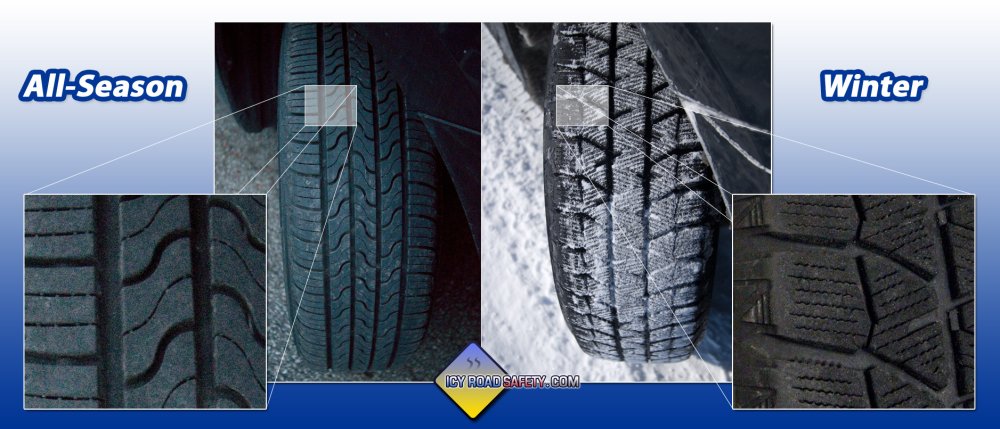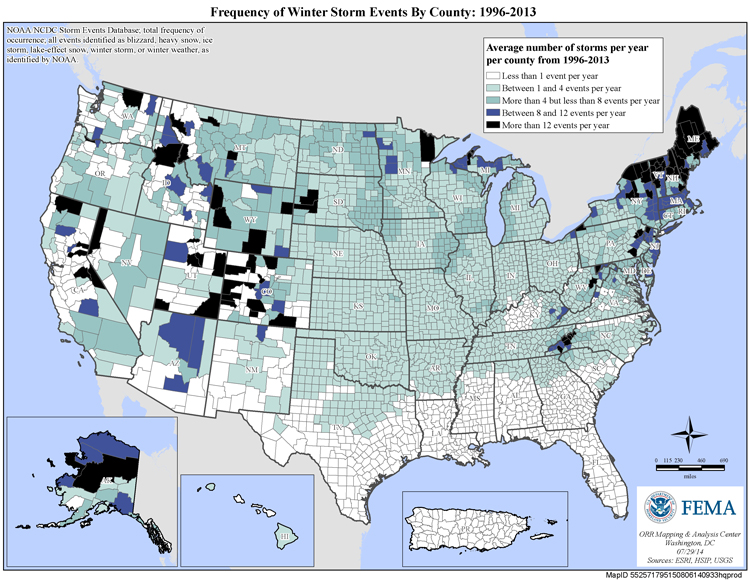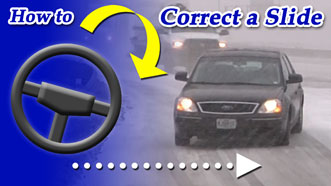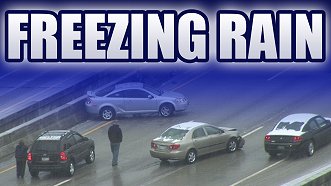Winter Tires: Myths and Facts

 |
By DAN ROBINSON
Editor/Photographer |
|
Underneath my Youtube videos about icy roads, you'll see dozens of commenters talking about winter tires. "Why aren't people using them?" "That's what they get for using summer tires" "Winter tires would solve all of these problems".
So what's the story? Are winter tires worth it? Are they the silver-bullet solution for preventing accidents during winter weather? To find out, in 2016, I purchased a set of winter tires (I paid for them personally) and used them during two seasons of my normal news coverage of icy roads across the country. I put them to the test on all types of road icing, from snow to sleet to freezing rain. In this article, we'll cover the results of these tests and separate the myths from the facts about winter tires.
Winter tires VS all-seasons

There are two main differences between winter and all-season tires. Winter tires use a softer rubber compound that is better at providing grip on snowy surfaces. The rubber in all-season tires, by contrast, tends to harden during cold weather and as a result, slide much more easily. The second main feature of a winter tire is the tread pattern (see image above). Winter tire treads have numerous narrow cuts in the tread called "siping" that give the tire an abundance of sharp edges that help "bite" into snow.
Contrary to popular belief overseas, most people in the USA use all-season tires instead of summer tires. FACT: Winter tires perform very well on snowpacked roads
Snowy conditions are where winter tires shine. On slight inclines where all-seasons would spin fruitlessly, winter tires grab and keep the vehicle moving with few issues. I was able to start from a full stop on this hill near Pittsburgh, with very little wheel spin. The car is noticeably more stable when driving on snow, with much less wheel spin or antilock brake action. As I'll cover later though, winter tires will still slide if you are going too fast for the conditions or encounter a steep enough hill.

Winter tires tackled this Pittsburgh hill with ease.
Combined with the essential practice of slowing to a safe speed for the conditions, winter tires will dramatically increase your overall safety and stability on snow-covered roads. MYTH: Winter tires are just as effective on ice.
I can assure you that winter tires will slide on ice with little provocation! I experienced just as much antilock brake action and general instability on the more slick types of road icing (such as freezing rain and untreated re-frozen snowmelt) as I do with all-seasons. Traveling too fast on the more slick types of road icing will get you into just as much trouble as you would with all-season tires.

Winter tires sliding on freezing rain icing
You've probably seen the "ice rink" tests where vehicle stopping distances are tested with winter vs all-season tires. The winter tires do have an edge in this department, but note that in those tests, the cars are traveling at relatively slow speeds on a flat, uniform surface. In the real world, there are hills, banked roads and generally higher speeds than what you can attain on an indoor ice rink.
On ice, the only effective solution for a meaningful increase in stability are studded tires. Stud use is problematic for most people in the US, as the incidence of icy roads is too infrequent to keep them installed for lengths of time. Furthermore, studs are not legal in some states because they are damaging to roads [1]. Studs also reduce dry-weather handling, as they cause less of the tire tread to be in contact with the road surface. MYTH: You can drive at normal speeds on icy roads with winter tires.
I'll reiterate this: winter tires can and do still slide on slick roads. They may have a slightly higher margin of safety than all-seasons, but they still have a limit! If you exceed that margin, you will slide and lose control in the same manner as you would with all-season tires. The bottom line is that normal-speed travel on icy or snowy roads is not safe, even with winter tires. In this respect, winter tires are far from a silver-bullet solution for preventing accidents if the driver doesn't slow to a safe speed for the conditions.
Like other vehicle safety features such as ESC, ABS and 4WD/AWD, winter tires have their limits. When the vehicle is driven beyond those limits due to overconfidence in the equipment, the end result is the same: an unstable vehicle state on the brink of a slide and loss of control. An overconfident driver with a safety-feature-rich vehicle will be at a greater risk of injury than the average driver as their accidents will tend to happen at higher speeds. FACT: Running winter tires involves additional expenses
Cost of the tires: In terms of the tires themselves, a set of good winters costs about the same as all-seasons. When I had a small Toyota Yaris, I paid around $450 for my set of a top name-brand version. That's about what I've always paid for a new set of all-seasons for that car. A set of winter tires can cost $800-$1,000 or more for larger vehicles like trucks and SUVs. In using winters, you do have the up-front cost of a second set of tires. This initial cost, however, is offset in the long run: your normal tire wear is split across two sets, so your all-seasons will last longer (you're only using them 6-8 months of the year).
Cost of the seasonal swap: A major cost consideration with winter tires is the process of switching them out with your all-seasons twice a year (in the spring and in the fall). Let's talk about the two ways this issue is approached:
- Using a second set of wheels: Many people who use winter tires buy a second set of dedicated wheels on which the winter tires are permanently mounted. This makes the seasonal swapping process easier and cheaper. The main drawback with this option is a not-insignificant up-front cost: you'll not only be buying a second set of wheels, but you'll also need a second set of TPMS (tire pressure monitoring system) sensors. Plain steel wheels are the cheapest option if you don't mind their appearance. With a set of dedicated winter wheels, you can quickly swap the tires out in your driveway at home with a good floor jack and a lug wrench.
One more consideration is that the vehicle's TPMS system needs to be reprogrammed to pair with the sensors each time the wheels are swapped, a process that for some vehicles requires a special electronic tool. Most tire shops will do your twice-a-year wheel swap and TPMS reprogramming for free if you purchased at least one set from them. Check with your vehicle manufacturer to see what is required to reprogram the TPMS system. Some vehicles might require a trip to a dealer, while with others you may be able to buy the tool and do it yourself.
- Using your vehicle's stock wheels: Using one set of wheels for both sets of tires is also an option. This saves you the up-front expense of the second wheel and TPMS sensor sets, but the seasonal swap requires ongoing mounting and balancing costs. Most tire shops charge around $80 to $90 total for this task (even if you bought the tires from them), and that will be a twice-a-year expense.
Repeated remounting of tires puts additional stresses on the bead of the tire, which could affect their lifespan. For this reason, many shops even have policies to not mount used tires, even though they may make exceptions for a set of winters purchased at their store. If you choose to go this route, make sure your shop will commit to performing the swap throughout the life of the winter tires.
Cost of storage: Regardless of which method you choose, you'll need space at home to store the second set of wheels/tires. That's not a problem if you have a garage or shed, but might be if you're in a studio apartment! If you don't have the available space at home, many tire shops offer storage services for an additional fee.
MYTH: Winter tires perform better than all-seasons in cold weather
This is a common selling point you'll hear from winter tire manufacturers. While it's true that some tests have given winter tires an edge over all-seasons on dry-road braking in subfreezing temperatures, this effect is not noticeable in everyday driving. I saw no perceptible difference in handling during dry, cold weather between my winter and all-season tires.
FACT: Winter tires handle very poorly in warm or rainy weather.
Since winter tires are made of softer rubber compounds, they are noticeably "squishy" during warm weather. This effect is really pronounced when temperatures rise above 50°F - it feels similar to the steering linkage being a little loose, especially at highway speeds. You can feel the car "wobble" during harder turns and cornering. The softer material means that winter tires will wear very fast in warm weather - you definitely don't want to leave them on very long once spring arrives.
More importantly, winter tires can be dangerous on wet roads at highway speeds. Nearly all brands have very poor wet-road braking performance. This instability is very noticable and is downright scary! I experienced an incident during hard braking on an interstate at 60mph with only marginally-wet pavement (with temperatures near 50°F): I began to fishtail and my electronic stability control (ESC) system activated to keep the car straight. I don't feel safe going greater than 50mph on wet roads when I have my winter tires mounted. This means if you see as much rain during the winter months as you do snow and ice (as we do here in St. Louis, for example), this effect cancels out the safety benefits of winter tires altogether. FACT: For most people in the US, winter tires are impractical
Yes, it's true: winter tires are amazing on snow-covered roads. So why doesn't everyone use them? The main reason is that for most places in the United States, icy roads only happen a handful of times a year. Most of the US is not like Finland, Sweden or Russia where roads are snowpacked for much of the winter. Where I live in St. Louis, we see ice or snow on the road only 5 to 10 times each year, and that for only a few hours at a time. In much of the Southern US, snow or ice on the road only happens once every 1 to 3 years.
The map below shows the average number of days that winter weather occurs, by county, in the United States:

Source: FEMA
As you can see, there aren't many places that see snow and ice on the road more than 10 times each winter. Given the cost of using winter tires ($1000 and up for the tires and second set of rims), that's a hard sell for most people. Outside of the more snow and ice-prone areas shown on the above map, winter tire usage is rare among the driving public in this country. In the southern two-thirds of the United States, most tire shops don't even stock them.
Furthermore, in regions with mild winters, the poor handling of winter tires outside of the few icy road events means that a vehicle's overall safety could actually decrease with winters installed.
All of this means that for most people in the southern two-thirds of the US, it doesn't make a lot of sense to go through the extra expense of winter tires when there are so few times that they'll be beneficial. You can greatly reduce your chances of an accident during the occasional icy road event by simply slowing down to a safe speed, even with all-season tires. And that's been the main message I've tried to convey on icyroadsafety.com: slow down for the conditions! I myself have spent 20 years covering winter storms and icy roads with all-season tires - even with a rear wheel drive pickup truck, and I can get around just fine on them as long as I don't push my luck with speed or on steep hills.
Furthermore, winter tires don't make a vehicle immune to accidents on ice and snow. Winter tires will still slide, especially on the more slick types of road icing. On freezing rain icing for example, I did not see a noticeable difference in braking performance. Conclusions
Should you buy winter tires? The answer primarily depends on where you live. In many northern-latitude locations such as Canada, winter tire use could be mandated by law. Even where they aren't required, winter tires are a no-brainer if you're in a more snow-prone location, particularly one with hilly terrain. Outside of those demographics, you should be able to get by just fine without them as long as you reduce your speed when snow and ice are a threat. Even the tire manufacturers agree - they don't stock winter tires in most places, nor do they attempt to market them outside of the snowiest regions. Driving at a safe speed for the conditions for those few days out of the year that the roads are icy (or better yet, staying home or postponing your travel) is an adequate strategy for dealing with the occasional winter weather event. If you are driving too fast for the conditions, winter tires will only slightly decrease your chances of losing control.
Sources
Educational Winter Driving Videos - Watch for Free:
  
Home | Risk | Stats | Accident Video | Icy Bridges | Tips | Warning Signs | If You Slide | If You Wreck
1,836
Average annual
deaths in the US
from icy roads
136,309
Average annual
injuries in the US
from icy roads
[ More Statistics ]
|
|

